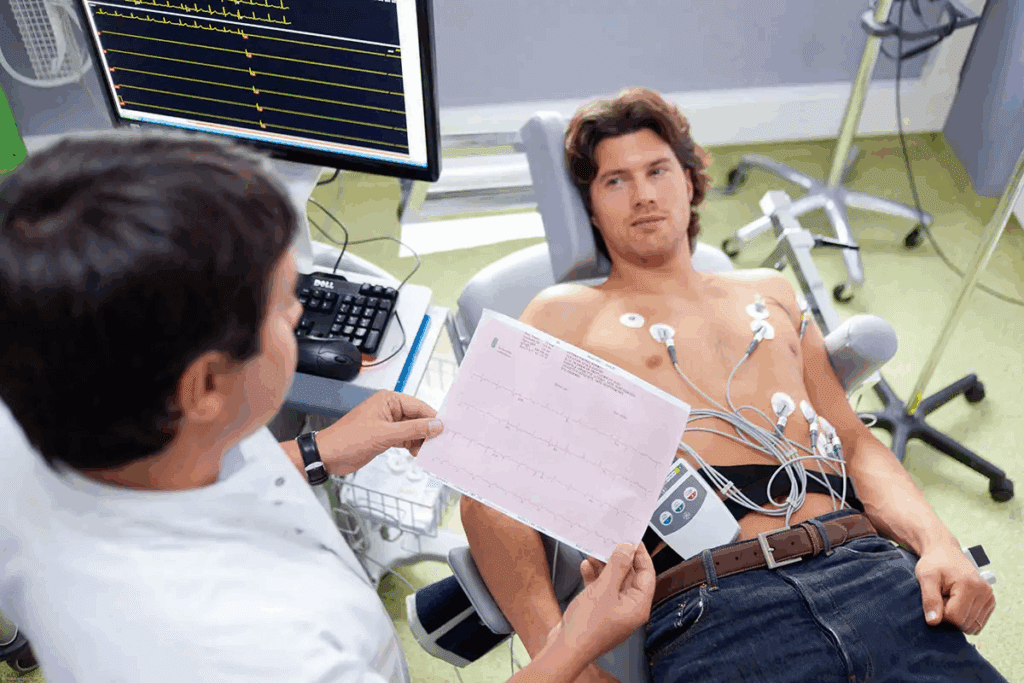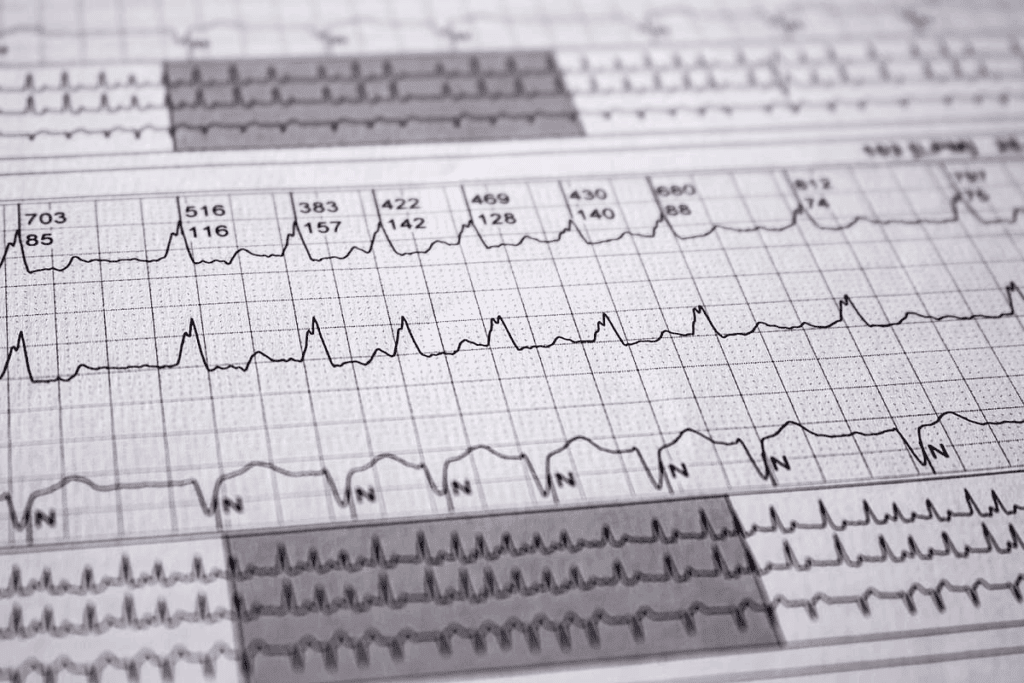Last Updated on November 25, 2025 by Ugurkan Demir

Discover top tools for detecting cardiac arrhythmias ecg — Holter monitors, patches, and devices.
At LivHospital, we know how important it is to find heart rhythm disorders quickly and accurately. We use the latest tools to help diagnose and treat heart problems. This includes Holter monitors and EKG patches for our patients.
Finding problems early is key to treating them well. Our team uses many tools to check and find heart rhythm issues. This way, we make sure our patients get the best care possible. Thanks to new technologies, we can spot arrhythmias better and tailor treatments for each patient.

It’s key to know about cardiac arrhythmias for good care and treatment. These irregular heartbeats can be too fast, too slow, or irregular. Some are harmless, but others can be deadly if not caught or treated.
There are many types of cardiac arrhythmias, each with its own causes and signs. The most common ones are atrial fibrillation, ventricular tachycardia, and supraventricular tachycardia.
Finding these arrhythmias early is key to avoiding problems and better care.
Getting a diagnosis early is very important. It lets doctors start the right treatment right away. This can really help patients live better and longer.
Cardiac arrhythmias can really affect how well a patient does if not treated. But, finding and treating them early can greatly lower the risk of serious problems. Doctors can then give treatments that really help each patient, leading to better health outcomes.

Diagnostic technology has greatly improved for cardiac arrhythmias. This has led to more accurate and efficient diagnosis. As a result, patients are getting better care.
The journey of diagnosing cardiac arrhythmias has seen many milestones. From the traditional electrocardiogram (ECG) to advanced Holter monitoring systems, each step has brought us closer to better detection.
The traditional ECG has been key in diagnosing arrhythmias. Yet, it has some big limitations. These include:
These issues have pushed for the creation of more advanced tools.
Holter monitoring has made big strides. It now offers longer monitoring and better data analysis. Modern Holter monitors are:
These improvements have greatly increased the accuracy of arrhythmia detection.
New technologies are changing how we detect arrhythmias. Some of these include:
These technologies are set to change the field. They promise more precise and personalized care.
| Technology | Advantages | Limitations |
| Traditional ECG | Quick and easy to perform | Limited monitoring period |
| Holter Monitoring | Longer monitoring period, more accurate detection | Patient compliance issues |
| ECG Patch Monitors | Long-term assessment, comfortable, and water-resistant | Data analysis challenges |
Holter monitors have been key in finding heart rhythm problems for years. They record the heart’s electrical activity for a long time. This helps find issues that a regular ECG might miss.
Holter monitors are small and portable. They record the heart’s activity for 24 to 48 hours. You wear them on your body, with electrodes on your chest, to monitor your heart rhythm all day.
Holter monitors have specific features like channel number, sampling rate, and memory. Modern ones have 3-12 channels, sample up to 1000 Hz, and hold enough data for the whole monitoring time.
| Feature | Description | Benefit |
| Number of Channels | 3-12 channels available | More channels provide more detailed information |
| Sampling Rate | Up to 1000 Hz | Higher sampling rates capture more precise data |
| Memory Capacity | Sufficient for 24-48 hour recording | Allows for extended monitoring periods |
Holter monitors are great at finding arrhythmias and checking if treatments work. They catch short events that a regular ECG might miss. This gives important info for diagnosis.
Healthcare providers can now monitor patients for 14 days. This longer time helps catch more arrhythmic events. It gives a clearer picture of a patient’s heart activity, key for diagnosing and treating arrhythmias.
Extended Holter monitoring has many benefits. It’s more likely to catch rare arrhythmic events that shorter systems miss. This is great for patients with symptoms that come and go.
It also leads to better diagnoses. Longer monitoring means more data. This helps doctors create more accurate treatment plans, which is a big plus for complex cases.
Research shows extended Holter monitoring is better than short ones. It catches more arrhythmic events over 14 days. This gives a fuller view of a patient’s health.
| Monitoring Duration | Diagnostic Yield |
| 24-48 hours | Lower detection rate for arrhythmic events |
| 14 days | Significantly higher detection rate, capturing more arrhythmic events |
Choosing the right patients for extended Holter monitoring is key. Those with symptomatic arrhythmias or unexplained syncope are best. Also, patients with suspected arrhythmias not caught by short monitors can benefit.
By picking the right patients and using extended Holter monitoring, doctors can make better diagnoses. This leads to more effective treatments.
EKG patch technology has changed how we monitor heart rhythms. It’s wearable and easy to use, making patients more comfortable and likely to follow treatment plans.
EKG patches are small and light. They let you move freely while monitoring your heart. These patches stick to your chest and record your heart’s activity for hours.
The design of EKG patches focuses on comfort and ease of use. They are designed to be as unnoticeable as possible, so they don’t get in the way of your daily activities.
These patches make it easier for patients to stick to their monitoring plans. They are comfortable and simple to use. This makes patients more likely to follow their treatment plans without hassle.
In medical settings, EKG patches are very useful. They help doctors check for heart rhythm problems, see if treatments are working, and make better decisions based on heart activity data.
ECG patch monitors have changed how we deal with heart rhythm problems. They let us watch heart activity for a long time. This gives us important info about how well the heart is working.
These monitors have cool features that help them work better. They record ECGs clearly, last a long time on battery, and spot heart rhythm issues.
Key Features:
Modern ECG patch monitors are great because they can get wet. This means patients can wear them all the time, even when they’re in the water.
The data from these monitors is checked by special software. It looks for patterns and oddities in heart activity. This is key for finding heart problems and planning treatments.
The table below shows the main benefits and features of ECG patch monitors:
| Feature | Benefit |
| Long-term monitoring | Provides detailed info on heart activity over time |
| Water-resistant design | Allows for wearing during many activities |
| Advanced algorithms | Improves finding of heart rhythm issues and other problems |
Thanks to these features, doctors can give better diagnoses and treatments to patients with heart rhythm problems.
Implantable cardiac monitors have changed how we diagnose and treat heart issues. These devices watch the heart over time, helping us understand arrhythmias and other heart problems. Knowing how to use these monitors helps doctors take better care of their patients.
Doctors often suggest these monitors for patients with recurring symptoms like palpitations or dizziness. These symptoms can be hard to catch with shorter monitoring methods.
Research shows these monitors are great for diagnosing issues in patients with cryptogenic stroke or suspected atrial fibrillation. The data they collect helps doctors decide on treatments like anticoagulation therapy or catheter ablation.
| Indication | Description | Benefit |
| Recurrent Syncope | Monitoring for patients with unexplained fainting spells | Captures arrhythmic events correlated with symptoms |
| Cryptogenic Stroke | Investigating stroke of undetermined cause | Detects atrial fibrillation and guides anticoagulation |
| Atrial Fibrillation Detection | Monitoring for patients at high risk of AF | Enables early intervention and stroke prevention |
Putting in a cardiac monitor is a minor surgery done under local anesthesia. The device goes in the left chest, with electrodes under the skin to catch signals well.
Like any surgery, there are risks like infection or bleeding. But these are rare, and the long-term benefits usually outweigh them.
The main advantage of these monitors is the continuous data they give on heart activity. This data is key for spotting arrhythmias and other heart issues that might not show up with shorter monitoring.
Doctors can use this data to create treatment plans that fit each patient’s needs. This improves care and lowers the chance of problems.
In conclusion, implantable cardiac monitors are a big step forward in managing heart arrhythmias. Their long-term monitoring makes them a critical tool for healthcare.
Advanced monitoring tools have changed how we find and manage heart rhythm problems. These tools have made a big difference in how well patients do. We’ve looked at the key tools for spotting and keeping an eye on these issues.
Studies show these tools work well in finding and handling heart rhythm problems. This leads to better care for patients. Doctors can now make more precise diagnoses and create better treatment plans.
These tools are very important. They help doctors spot heart rhythm problems early, which lowers the chance of serious issues. As technology gets better, we’ll see even more ways to help patients with heart rhythm problems.
A Holter monitor is a portable device that records the heart’s activity for 24 to 48 hours or up to 14 days. A traditional ECG, on the other hand, captures the heart’s activity at just one moment in time.
An EKG patch is a small, sticky device that records the heart’s activity. It’s made to be worn for a long time, giving a continuous look at heart rhythms.
ECG patch monitors have many advantages. They allow for long-term monitoring, are water-resistant, and can analyze data in detail. These features make them great for spotting and managing heart rhythm problems.
A 14-day Holter monitor is meant to be worn for 14 days. It’s designed to monitor heart activity over a longer period.
An implantable cardiac monitor is a small device put under the skin. It tracks heart activity for a long time. It’s often used for patients who need ongoing monitoring.
Yes, many ECG patch monitors are water-resistant. This lets patients do their daily activities, like showering or bathing, while wearing the device.
Subscribe to our e-newsletter to stay informed about the latest innovations in the world of health and exclusive offers!